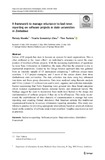Please use this identifier to cite or link to this item:
https://cris.library.msu.ac.zw//handle/11408/4143Full metadata record
| DC Field | Value | Language |
|---|---|---|
| dc.contributor.author | Maseko, Melody | - |
| dc.contributor.author | Zhou, Tinashe Gwendolyn | - |
| dc.contributor.author | Tsokota, Theo | - |
| dc.date.accessioned | 2021-05-10T08:38:34Z | - |
| dc.date.available | 2021-05-10T08:38:34Z | - |
| dc.date.issued | 2020-05-31 | - |
| dc.identifier.issn | 13602357 | - |
| dc.identifier.uri | https://link.springer.com/content/pdf/10.1007/s10639-020-10235-y.pdf | - |
| dc.identifier.uri | http://hdl.handle.net/11408/4143 | - |
| dc.description.abstract | Failure of IT projects has risen to become an eyesore for most organisations. This is often attributed to the ‘mum effect’- an individual’s reluctance to report the exact position of troubled software projects. With the increasing digitalization of operations by most State Universities in Zimbabwe, the mum effect has the potential to rise to exponential proportions. Guided by the Design Science approach data was gathered from an intensity sample of 15 participants comprising 7 software project team members, 3 ICT project managers, and 5 users of the system drawn from three Zimbabwean state universities. The data collection was done using key informant interviews and focus group discussions. Data were analysed using thematic analysis and NVivo (version 11) software was used to store, organise, and code data transcripts. Factors suppressing Bad News Reporting were grouped into three broad categories which included organisational factors, personal factors, and situational factors. The findings suggest the need to incorporate these multi-level factors in the design and implementation of software projects if they are to be efficacious. This study recommends the establishment of clear channels of communication to manage bad news reporting and creating formal structures that function outside the traditional organisational hierarchy to convey information regarding anomalies. This study contributes to practice by providing appropriate interventions based on empirical evidence based on the centrality of software project team members’ insights, experiences as well as practices. | en_US |
| dc.language.iso | en | en_US |
| dc.publisher | Springer | en_US |
| dc.subject | Bad news reporting | en_US |
| dc.subject | Software projects | en_US |
| dc.subject | State universities | en_US |
| dc.subject | Zimbabwe | en_US |
| dc.subject | Framework | en_US |
| dc.title | A framework to manage reluctance to bad news reporting on software projects in state universities in Zimbabwe | en_US |
| dc.type | Article | en_US |
| item.fulltext | With Fulltext | - |
| item.grantfulltext | open | - |
| item.openairetype | Article | - |
| item.cerifentitytype | Publications | - |
| item.openairecristype | http://purl.org/coar/resource_type/c_18cf | - |
| item.languageiso639-1 | en | - |
| Appears in Collections: | Research Papers | |
Files in This Item:
| File | Description | Size | Format | |
|---|---|---|---|---|
| tsokota.pdf | Article | 536.9 kB | Adobe PDF |  View/Open |
Page view(s)
240
checked on Dec 20, 2025
Download(s)
134
checked on Dec 20, 2025
Google ScholarTM
Check
Items in MSUIR are protected by copyright, with all rights reserved, unless otherwise indicated.



